Of all the wonderful ideas in Portland’s Bicycle Plan for 2030, the one I personally hope is never forgotten is its audacious use of a numeral: 25 percent.
That’s the target it set for the share of trips that could happen by bicycle in Portland. Today, the figure is something like 7 percent. Only several dozen cities in eastern Asia and northern Europe, probably, can currently boast 25 percent or more.
But 25 percent is possible and even imaginable, as BikePortland reader Alex Reedin spelled out in a Thursday morning comment estimating the payoff for each step that’ll be required to get us there.
It came in reply to another reader’s speculation that between bike sharing, new greenway diverters and better downtown bike lanes, Portland might be near a “tipping point” for biking.
I’d say there are many tipping points. We’re finally making substantial progress towards some. A few years ago, we were making veery slow progress which was in my opinion partially being taken back by increased driver meanness and shortcutting.
1) Some inner-Portland infrastructure, enough for sort of a network + drivers on average nicer compared to the rest of the U.S. –> enthused, confident, fit, prime-age people with origins and destinations in inner Portland bike, much more so in the summer than the winter. PASSED! (~6-8% mode share)
2) Truly comfortable inner-Portland infrastructure –> interested but concerned people of all ages with origins and destinations in inner Portland bike if they feel like it, much more so in the summer than the winter. MAKING PROGRESS (~5% additional mode share)
3) Some outer-Portland infrastructure, enough for sort of a network –> enthused, confident, fit, prime-age people with origins and destinations fairly close to each other in outer Portland bike, much more so in the summer than the winter. MAKING PROGRESS (~4% additional mode share)
4) Truly comfortable outer-Portland infrastructure –> interested but concerned people of all ages with origins and destinations fairly nearby, much more so in the summer than the winter. NOT EVEN CLOSE (~3% additional mode share)
5) Biking is more convenient than driving for most trips in inner Portland (greenways paved well and made convenient, major street protected bike lanes, car parking expensive/annoying, cars stuck in traffic)–> interested but concerned people of all ages with origins and destinations in inner Portland bike, all the time, unless it’s pouring. People traveling from outer Portland to inner Portland may start to e-bike in sizeable numbers, though still far from a majority (~7.5% additional mode share)
Advertisement
That final step, Reedin confessed in a follow-up, is the hardest and the one Portland is furthest from. But though you might disagree with the percentages he assigns to each step in this recipe, it’s encouraging to break down this difficult civic mission into more or less comprehensible steps.
Of course, the point of bicycling isn’t bicycling. If the 2030 Bike Plan has a failing, it’s that it didn’t create a durable consensus about why it would be a good thing for Portland to achieve 25 percent bicycling mode share.
But of course there are many reasons, from affordability to safety to community to physical quiet to clean air to economic prosperity. As long as Portland can keep moving along this path — and for all our grousing, it clearly is — those benefits will keep arriving in greater and greater amounts.
That’s how our city will, eventually, muster the political will required for that final crucial step.
Yes, we pay for good comments. This regular feature is sponsored by readers who’ve become BikePortland subscribers to keep our site and our community strong. We’ll be sending $5 and a little goodie bag to Alex in thanks for this great addition. Watch your email!
— Michael Andersen, (503) 333-7824 – michael@bikeportland.org



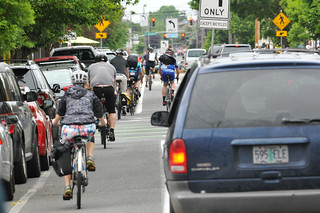
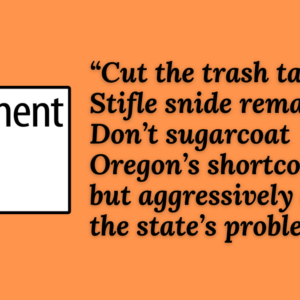
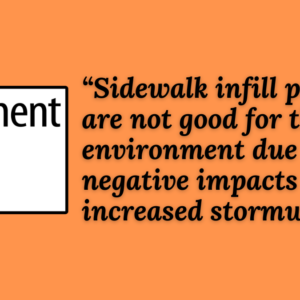
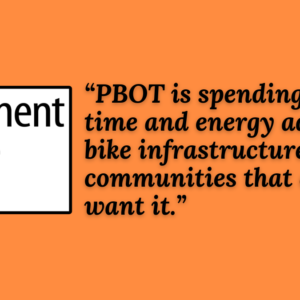
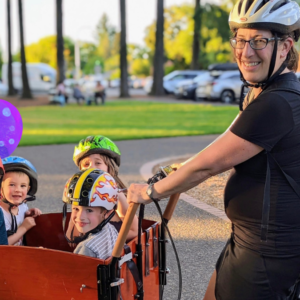
Thanks for reading.
BikePortland has served this community with independent community journalism since 2005. We rely on subscriptions from readers like you to survive. Your financial support is vital in keeping this valuable resource alive and well.
Please subscribe today to strengthen and expand our work.
So basically: infrastructure, infrastructure, infrastructure, infrastructure, infrastructure, with a smattering of parking removal? Yeah, sounds about right. 🙂
Every time I see an orange bike stachion on the street, I wonder how the city was able to take those parking spaces, but can’t seem to do that for safer bike routes, a matter of life and death rather than just profit.
I have been listening to my in-laws and their friends. “They hate bicycles!” My wife included. Each of the individuals has a minimum of 2 cars and live in NorthWest PDX and park in the street. Typically they will drive everywhere over a block, park up to 4 blocks from where they are going and gripe and complain every step of the way.
My wife’s biggest complaint is that I go to bed really early this time of year (around 8:30pm) so that I can get up at 4:30am to get ready to ride in. It’s SIGNIFICANTLY safer for me to ride at 5am & 3pm than it would be to ride at 7am & 5pm.
Better conditions for cycling would certainly make my life a lot easier.
The City’s goal of 25% bike mode split…is achievable…though it is becoming something similar to the ‘saving for one’s retirement’…if started early enough and if steady progress is made then small incremental changes can achieve it…but as is so often the case if progress is postponed or funding is cut then one most take more radical measures to reach the goal set […or the goal date may need to be pushed back to 2050 or never reached.]
The game changer may be bike share if it becomes a commute trip as bike transit option delivering >40% mode share in the city core so as to make up for other districts lagging below the 25% goal where cycling has more barriers to overcome.
Alex, as the “other reader” whose comment spurred yours, I’ll be expecting my cut of the winnings in the mail soon 😉
I think it’s ok when people disagree with each other. I would disagree with Mr. Maus and Mr. Reed.
I agree 4 points of Infrastructure are one good component. I agree we must have street safety before people feel safe enough to change their commute from driving alone to bikes/transit.
—-But I would say Alex is narrow on his tips.
We need a whole puzzle of fixes to get transit solved. It’s more than just Infrastructure. Diverters are a part. Citations are HUGE missing part. Lawmakers who do what they say are a missing link. Getting repeat offenders off the roads is key.
Another fix: Stop endorsing your oppressors. I wrote about that here:
https://docs.google.com/document/d/1odUY1ujfq2yexerGd4qk5JYPVmoe-1GFKFgPYZoKye0/edit?usp=sharing
Hear, hear to all you wrote. I love both your positions and the actions you take. Budgets are expressions of priorities, and our priorities are clearly much more car-centered than is appropriate at this point in history, whether “our” political class will admit it or not.
I think what you’re talking about is mostly the missing “step 0” of making biking a priority (for the reasons Michael points out in the article above.) I like the idea of citizen-installed diverters, but if you can muster that much effort, we would probably get more results from citizen-issued citations and would not need any permission to do it.
Amen Eric. Keep the great ideas flowing. Zero cost citations for anyone who is in a car and a safety risk and breaking the law. If we can have camera citations, why not citizen issued ones.
In fact police could do photo citations without leaving their car. Here’s news on that
http://www.theatlantic.com/politics/archive/2016/07/end-needless-interaction-with-cops-during-traffic-stops/490412/
I’ve looked into and worked toward doing more citizen citations. Considering a lot of the police don’t even know those exist, it’s hard to rally up enough people to make it have an impact. I’d love to try though, it’d be great to give the bridge and tunnel crowd motorists a reality check that no, Portland indeed does NOT like aggressive drivers tearing through our neighborhoods and threatening us, we will ticket those that do.
…however so far the time and effort needed to continually write citizen citations and such needs to be dramatically simplified. I’m pondering actually writing an application for it for those that want to do it. Evidence is pretty easy to collect on a simple phone that has solid HD video (i.e. an iPhone 5 or better, many Androids, etc)…
My girlfriend and I were trying to figure out a business model for making a living writing citizen citations… but not sure if there’s enough grant money out there that can be gathered for that effort…
” bridge and tunnel crowd motorists”
Really, it’s all an issue of folks from outside city limits causing the problem?
You might want to rethink that.
The term “bridge and tunnel” motorists was coined to describe the stark scenario in the recent past where a job rich community (Manhattan) had very low car ownership (<50%) but where the City [and State] DoT would do almost nothing to assist multimodal travel for its citizens while facilitating suburban commute trips. The influx of car trips into Portland is no where near how bad it used to be in NYC but I wish Portland had more NYC tools in its tool box like bridge tolls, 24/7 transit, etc.
Actually it was a derogatory term meant to differentiate between the city folk and the poor country folk who had to commute into Manhatten to work.
It has nothing to do with car ownership, it has everything to do with the folks who couldn’t afford to live in the city but had to commute.
https://en.wikipedia.org/wiki/Bridge_and_tunnel
I’m thinking point-to-point speed enforcement. As long as you can show that the time measurement is accurate (easily verified by carrying a stopwatch from one camera to the other), you have a +/-0.7 mph precision at 0.1s resolution over just 150ft. Filing a few thousand tickets for 35 in a 25 would at least require the police and/or court to explain their blatant disregard for the laws of physics.
Stop sign, cell phone, and crosswalk violations might be easier to prosecute.
Might as well get this out of the way.
I don’t want more bike lanes. The worst parts of any ride around Portland involve a bike lane. The best parts are never in a bike lane.
I’m at a loss to explain why we never even came close to a complete network, but we’ve now decided that the standard has changed and we need to start over. If we start now, in ten years we still wont’ have a complete network. Can you convince me that you’re not going to change it again? I still feel like we’re trying to trick people into riding with unsafe lines and walls, only to have them run over at the first intersection they come to.
Is this nothing but more experimentation for PBOT engineers?
The more times you start over the less support you’re going to get.
I agree. Painted bike lanes are the standard of 1990. It’s 2016, why are we still installing substandard cycling infra?
I agree so much new work by PBOT that they call bike lanes is very risky and sub standard. Just look at where the Williams bike lane ends at Killinsworth. Or look where the Westbound Hawthorne bike lane ends at the bridge. That’s a festering sore that is so dangerous and could have been fixed instead of paving 2 blocks of a smooth street N Bryant.
now I was just cycling in Seattle and they have some sweet protected bike lanes downtown. Not needed everywhere, but man did I feel safe suggesting my kid ride alone there. I am serious. A kid could commute on those lanes and signals.
Peace,
A lack of money and right-of-way in inner Portland. A lack of political will and PBOT-spine in East Portland (but plenty of money and ROW.)
Most transportation planners in the U.S. are far too timid about laying down any sort of “permanent” (i.e. separated, and firmly anchored in concrete) bike infrastructure. It’s as if they’re not quite sure whether it will be used or socially accepted, and fear some sort of backlash as a result. Think about it: All those bike lanes delineated only by paint are cheap, easy, and quickly and entirely removable if necessary. Easy in, easy out.
Paul – speaking as a transportation planner…historically it was not so much as planners being timid to do the treatments you are talking about but the US engineers who did not embrace it. Until NACTO and its adoption by city a state DoTs these tools were pretty much off the table unless all other solutions were ruled out.
Though the field of transportation planning can be faulted for failing to fight the politics of ‘streets are only for car parking’…and the land use codes that are the foundation of this and that frame the problem-solution scenario that engineers are then tasked to design a project to fix.
…a vicious circle affecting our communities since et 1920s/1930s.
I’m not sure what Alex meant by outer Portland. I’m going to assume North Portland north of Rosa Parks, East Portland east of 82nd, and SW beyond Tewilliger. The problem with his analysis for the outer areas is that commuters in those areas, including those who bike, are more often trying to get to jobs, schools, or commercial districts that are nowhere near downtown, but are commuting in other directions – to jobs in the Columbia Corridor or Clark Co (for North and East), Gresham & Clackamas (East & inner SE), and Washington County (SW). Such users are not likely going to be even using the excellent facilities projected for inner Portland, but the continued lousy “bike lanes” that Multnomah County built in the 1990s during annexation. In addition, both East Portland and Clark County are growing at a far faster rate than inner Portland in term of the number of people moving there. East Portland is already 28% of the Portland population by official city numbers, and will have well over a third of the city population by the time that Portland reaches the 25% bike mode split that Alex calls for. Basically, if you don’t replace the existing East Portland bike lanes now with protected bike lanes and cycle tracks, with improved intersections, you will simply never achieve the 25% split – it’s simply not mathematically possible without at least a 20% mode split in East Portland.
Very true. I tried to account for the distance-to-destinations issue by giving “bumps” for outer Portland that were half the size of inner Portland despite similar population sizes. Even that may have been too generous – but I think if you do real all-trip mode share, including schools, shopping, parks, and churches which are often within biking distance for outer Portlanders, you might get close to half the biking with the same infrastructure. A third is probably more accurate….
Alex, it took me a while to understand your analysis system. Basically, you describe a bikeway type, such as a neighborhood greenway or bikeway, and what portion of the 25% will come from users of the bikeway type, from different user groups (fearless vs interested-but-concerned). Users leave their house, get onto the local street, then a low-car-volume collector that may have an unprotected bike lane or a set of diverters, then progressively more protective facilities (buffered-bike lanes, MUPs, cycle tracks, parking-protected bike lanes, and/or barrier-protected bike lanes), until they get to their destination either downtown, near downtown, or at one of the numerous inner portland employment areas. Essentially, it replicates the “cascade” type system we have for car driving, but on a different scale and network.
It is dependent upon a land use system whereby most residents who bike do not live right on a busy arterial, but in residential areas away from commercial corridors.
However, with the standard land use zoning separation as done in most of the USA built on a minimum of over-congested roadways, the system you’ve so ably described immediately breaks down. A majority of Portland residents who live in East Portland and some parts of inner portland (and much of the rest of the USA, alas) live in apartments built right on busy arterial roadways (required by the County in the 1960s & 70s as “best practice” at the time, and perpetuated by the city after annexation in the late 1980s). Creating a safe and pleasant environment on an essentially auto-centric expressway is very costly but necessary to get to our goal of 25% on such streets.
The system you’ve described is what I’ve seen in smaller (flat university) UK cities of less than 200,000, such as York & Cambridge (and Lucca Italy), which actually do have 25% bike mode splits for all trips, as well as in Benelux, of course. However, I have never seen such a mode split in any hilly city in Europe, especially those over 600,000 in the city and 2.3 million in the metro. Hilly regional cities like Genoa, Zurich, Stuttgart or Lyon for example have low ridership rates compared to flat national capitals like Amsterdam, Brussels, or Copenhagen, who have far greater financial resources than Portland will ever have.
Keep up the good work!
What? North of Rosa Parks is as close in as 3 miles. Sellwood is further out. That said, this constant focus on East Portland should not slight the lack of connections off the peninsular (n. of Rosa Parks/w. of Interstate).
The idea that folks work where they live is absurd and clearly noted by observing auto traffic daily. There was a time when I knew 10 people living off Belmont/Hawthorne working for Nike.
There’s no doubt East Portland needs grid improvements, but safe bike blvds heading to the central west side are crucial to improving at least an interests in cyclist. We need more Springwater corridors — because without the Springwater everywhere from Brooklyn to Sellwood seems a lot further out.
And for fun Google Map a bike route from the Pearl to St. Johns. Suggested Route: Dirty 30 and glorified sidewalk running along Columbia — NO ONE TAKES THESE ROUTES.
Try routing from East Portland to graveyard shifts in the St Johns – North Burgard area.
Both TriMet and the Portland bike network are designed to get folks to and from downtown, but the highway network reflects (better) the actual job commute patterns. Trimet, to its credit, now gets this, and has in reply eliminated fare zones and is improving transit service between poorer suburban districts, such as Aloha and East Portland, and industrial areas. However, PBOT is still slow to catch up on its bike and pedestrian network, and this is completely off the radar for the BTA & BP.
That’s a long crappy commute via grid or MUPs for most.
Swan Island too.
Your points are valid. The city needs to stop hanging their hats on subpar networks that serve a very certain segment of the population — both in transit and cycling.
Funny that you mention Sellwood, a neighborhood that has exactly zero bike lanes in it. Although we have the Springwater, with mixed results.
I think that biketown can help highlight the need for all the bike infrastructure necessary to increase ridership especially if the gps data that is created from each ride is utilized. Spare no expense. Step aside car-reliance. The car free revolution is near.
Michael’s “physical quiet” might be the benefit I appreciate most when I have it, and miss the most when I don’t.
Totally agree. The street I live on is so loud all the time. It’s really nerve-racking.
You picked the place.
Yeah that “physical quiet” is only a dream when riding bikes in east Portland. Love riding that Halsey overpass at 205. Uggh. Then the joys of 122nd. Double Uggh.
It’s peoples’ attitudes more than lack of infrastructure that holds people back. Yes, people say they need the infrastructure, but this feels a lot like the excuses lots of folks give for not exercising. They know it’s a good idea and may even support it, but they don’t do it for a lot of reasons.
If it’s really about infrastructure, why does the number of cyclists totally crater when the weather changes or when the days are short? Do you really think the people who whine about walking from their front door to their car in the wet are ready to stay out for at least 1/2 hour each way? That people who spend loads of time on hair/makeup/clothes looking perfect because they are required to look sharp at work will suddenly decide pedaling is the way to go? If you have much to carry, kids to deal with, or significant distances to cover, cycling becomes much less attractive unless you’re really into it.
Even for people for whom cycling is a good match, I personally think the cycling community itself is part of the problem. Rather than helping newer cyclists learn to be safe and encouraging everyone to be mindful, we harp on the dangers and insist on special facilities which frankly play right into the arguments who think we don’t belong on the road in first place.
I could see people taking a lot more short bicycle hops if it were more convenient — BIKETOWN is intriguing, except the service area is very limited and it has somehow gotten associated with gentrification for offering a month’s worth of transportation for the price of 5 bus tickets or a couple packs of smokes.
I hear most of what you’re saying. It is indeed large part lousy American attitudes and entitlements that cause a lot not to bike when they could and should probably. Even when it would serve them better then spending hard earned cash maintaining and auto-dependent or auto-heavy lifestyle. As for the “look good” etc contingent, that’s a US infrastructure problem for sure. The beautiful people of Amsterdam, Groningen, Copenhagen, Krakow, Hamburg, Oslo, and many other places are healthier and sexier then the auto-dependent of the US.They all bike in massive numbers – one massive issue we have is our disturbing necessity for helmets because our infrastructure and drivers are so lethally bad for everybody on or near roads. All the places above, besides biking and generally being healthier are also dramatically safer in almost every measure…
We’ve got a long ways to go to get into their realm. But hey, I’m game for the effort and I suspect a LOT of others Portlanders are up for it too! 🙂
“our disturbing necessity for helmets” — “disturbing obsession” maybe? Not wearing a helmet makes me statistically safer if it makes even one person more likely to ride. And in my experience with a helmet, drivers tend to give you less space (I don’t get it: because they feel safer getting closer, or you look like a pro so you probably wouldn’t mind?)
I can see some benefit for helmets in solo over-the-bars crashes, but that would still be the case with separated infrastructure. If you’re wearing a helmet because of drivers, maybe wearing a rifle across your back is more appropriate? (Only slightly kidding.) What about pedestrian helmets? Dog helmets should definitely be required by law at all driveway and street crossings.
A wide-brimmed hat is actually much safer than a helmet because it will blow off at about 20mph. This could work for drivers too — like maybe we should ban windshields in the city.
No windshields or A-pillars on cars would make everyone a lot safer.
…and back to the jeep/ land rover or boat tail speedster with the fold down windscreen…plus all drivers should wear a helmet too, right?!
After “unless you’re really into it”, add “or you have an electric assist cargo bike”. People borrow $30k for a car and expect to match that ease and comfort with a $100 bike and no fenders? Velomobiles are still priced for hand-built scale at about $8k (granted, most of them don’t park as easily or fit on our sidewalk-themed infrastructure as well as a bike.)
As someone who owns a velo, a couple ‘bents, racing bike, etc I still live way more cheaply than someone with an SUV.
But perception defines reality, it’s not about practicality. I’ve got about 6K invested in some serious hardware which is cheaper than most vehicles. But somehow the image is that I’m some high falutin’ type.
Am I the only one who is disturbed by a goal that involves “prime-age people” as a means to increase biking. I mean, we’re not talking about encouraging non-prime-aged people to move out, right?
Respectable percentages of older people get around by bike in some communities. At the condo I used to live at, the 70 somethings seemed to ride more than the 40 somethings. In the places I lived in before I moved to Portland, cycling seems dominated by middle age and up — one of the major concerns of our club which contained hundreds of members was how to attract more young people.
I suspect the reason they’re targeting “prime age people” is that they make a lot of trips and a high percentage of them are physically capable of cycling. If people who don’t need to be in cars/shuttles/whatever take bikes, it improves travel options for those that do. The fewer people take cars, the more open the roads are and more available the parking.
Sadly, one major impediment to 25 percent, or even 7 percent – aside from the usual cultural issues, is the brutal fact that more and more “car” people are moving to Portland with their cars, which they will use for all their errands, and will continue to do so for a while.
A friend recently told me she was planning to move to Portland and asked what I thought about it. I replied by telling her that I didn’t mind PEOPLE moving here, that doesn’t bother me. But I was really against people moving here with cars which they would then use to pollute and endanger the city and further deteriorate our quality of living… she didn’t like that answer…
I hate to say it, but hopefully that discouraged her. One less car.
Charging a lot for parking will also encourage people not to bring their cars.